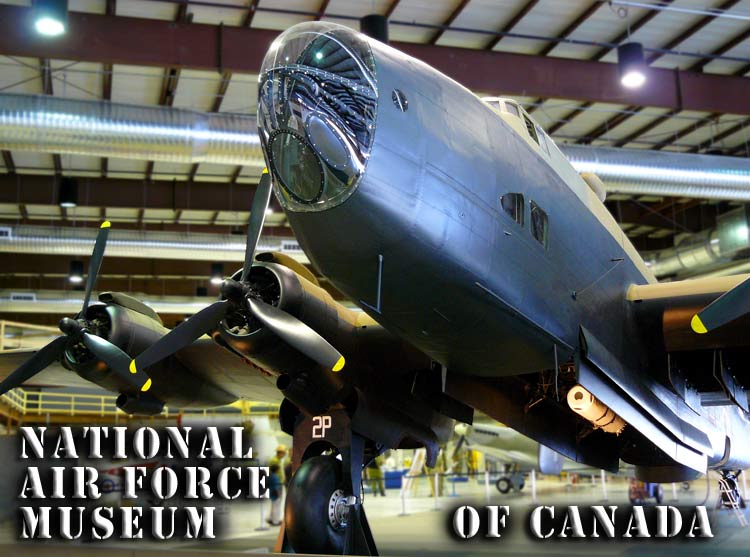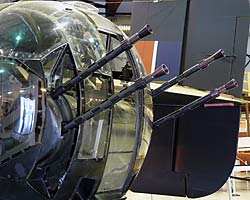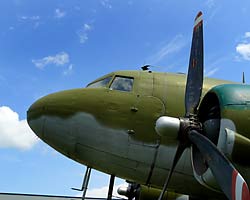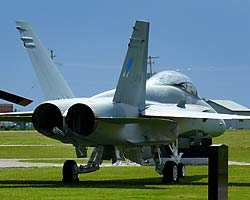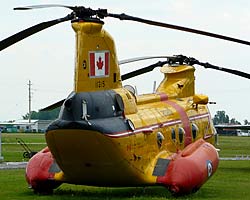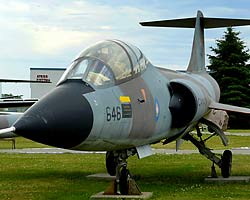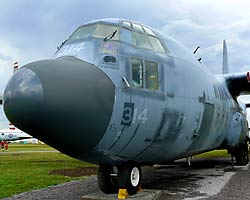National Air Force Museum of Canada
The National Air Force Museum of Canada is located in Trenton, Ontario in Canada. The museum was formerly known as the RCAF or Royal Canadian Air Force Museum and is owned, operated, and staffed by the Canadian
Department of National Defense.
The National Air Force Museum of Canada is unique in that they have the only Handley Page Halifax WWII British bomber in North America. The restoration of their Halifax is particularly amazing as the airframe sat at the bottom of a lake in Norway for 50 years before being raised and transported across the Atlantic to this museum. According to the docent the aircraft had been entirely rebuilt, using existing parts where possible and fabricating new when not. The only items that are not correct are the main landing gear castings which were originally magnesium but corroded away to powder during its 50 year submersion. While the restoration is mostly complete, the Halifax will remain a static display and not be flown or run up on the flight line.
The indoor portion of the formerly named Royal Canadian Air Force Museum is housed in a new hangar which was still under construction when I visited in the summer of 2009. The Halifax is the main exhibit with the Auster AOP, Burgess Dunne Floatplane, DeHavilland Chipmunk, Supermarine Spitfire and aircraft engines in the rear portion of the hangar. The smaller aircraft are packed fairly tightly together, and are easily viewed although part of the aircraft next to it may block part of an airplane from some angles. When construction is complete it is planned to spread the aircraft out more to make for easier viewing. There is a balcony above and around the Halifax which would provide an excellent view of the British bomber (which also served in the RCAF in WWII), unfortunately the public are not allowed up there. The Halifax has a number of informative signs and exhibit cases around the front of the bomber. However they do run from waist to eye level in height and do obscure parts of the aircraft if you are trying to get a wide view of the bomber. That was my one disappointment, as the quality of the museum's staff and volunteer's restoration work on the big British bomber is outstanding. Considering what it took to take this lake bottom wreck to a first class restoration that is close to airworthy I would think they would not want it obstructed from any angle. The Halifax really looks great, and it is displayed so you can see some very interesting details like the glider towing point and the internal wing mounted bomb bays. The museum staff have cleverly installed 10 cameras inside the bomber to allow visitors a real time virtual walk through of the interior of the airplane.
Also indoors is a large viewing window to the airplane restoration area. While I was there a North American Harvard and an Avro Anson were in the process of being restored. The Avro Anson looked like a good portion of the components were being rebuilt from scratch, especially the wing ribs.
The outdoor area of the formerly named RCAF Museum hosts several more modern jet fighter aircraft including an F-104 Starfighter, an F-5 Freedom Fighter, A Canadair Sabre 6, a Canadair CT-114 Tutor, an F-101 Voodoo Fighter, and a CF-118 Hornet, a Dehavilland S2 Tracker, MiG-17 jet fighter in a striking East German air force livery, and several others.
The National Air Force Museum of Canada is about an hour and a half east of Toronto in traffic, and about 3 and a half hours west of Ottawa close to the northern shore of Lake Ontario. There is no food on site, but a Tim Hortons is across the street and their sandwiches were pretty good. The museum has a very good gift shop, with some of the best looking designs on a couple of their shirts and hats that I'd seen at a museum. A hat with an RCAF roundel is a must, and the yellow T-shirts with the museum emblem are very cool. Have a look at what they have on the museum's website before you go. The one's I liked best were not out on the floor but they did have them in stock in the back. Food and lodging were a short drive into town and pretty reasonable. Parking is free, easy and close and the museum is very handicap accessible. Paved paths lead to the outdoor exhibits, and even with a wheelchair you'll be able to view the aircraft quite easily. There is no admission fee, but donations are accepted and more than welcome. The staff were friendly and knew their stuff. They were also busy too, shifting between internal restoration of the Halifax to welcoming and talking with visitors. See the National Air Force Museum of Canada's Website for hours and directions.
|
